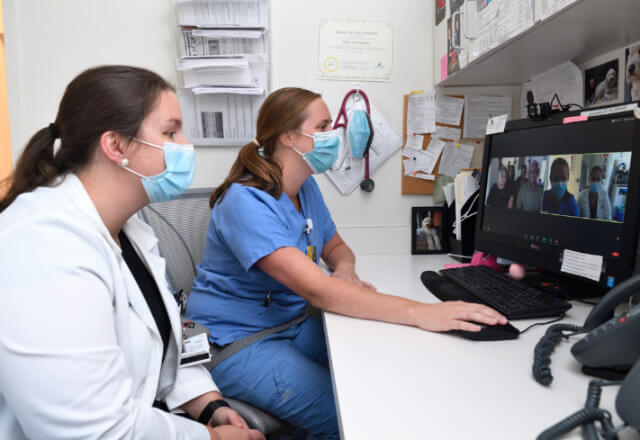Johns Hopkins Telemedicine Helps Patients Stay Healthy During COVID-19 Pandemic

Throughout the COVID-19 pandemic, certified nurse practitioners Sarah Riley and Abby Hubbard have conducted regular telemedicine visits with their patients Albertha and Charles Henry Ford.
Albertha and Charles Henry Ford, both in their 80s, have heart failure and associated health issues. Thanks to newly expanded virtual care options through Johns Hopkins telemedicine, however, the Fords have been able to stay healthy and remain connected with clinicians who have tracked their conditions and adjusted treatments during the COVID-19 pandemic. Since March, the couple, together with their daughter and caregiver, Roxanne, has had video visits with clinicians at the Johns Hopkins Heart Failure Bridge Clinic roughly every three weeks.
“I love telemedicine, but the thing is, all three of us are people people,” says Roxanne. “We want to connect with people in person, but it’s just not our reality right now because of COVID-19.” The family now uses video conferencing for many activities, including attending church and chatting with friends and family members. “I’m grateful that Johns Hopkins jumped on board so quickly, knowing that we were in this dangerous pandemic, and gave us this option.”
Making Telemedicine Work for Patients and Clinicians
During telemedicine visits from their home in Fort Meade, Maryland, Roxanne can maneuver the computer camera to help clinicians examine her parents’ legs and ankles for fluid retention, as well as look at veins in their necks to detect any elevation or distension that could indicate fluid. When tests are required, the family goes in person to a nearby lab, saving a trip to Baltimore. In between visits, Roxanne follows the clinic team’s instructions to monitor and report any changes in her parents’ health.
“All of our Johns Hopkins doctors have been very personable, and they’ve been able to get on the video line and see what they need to see,” says Roxanne. “You know, sometimes it’s just looking at my mom and dad and they can tell something’s good or something’s bad. That’s what we’re relying on and it’s been working.”
Albertha was diagnosed with heart failure about seven years ago when the family was living in Texas. She has been a patient at the Johns Hopkins Heart Failure Bridge Clinic since the family moved to Maryland in 2016. Albertha has heart failure with preserved ejection fraction (HFpEF), a condition in which the heart muscle is stiff and has difficulty relaxing, sometimes causing fluid retention and symptoms such as shortness of breath or decreased exercise tolerance.
In January, Charles, a retired U.S. Air Force technical sergeant, was diagnosed with amyloidosis, a rare condition in which abnormal proteins are deposited in the heart muscle.
When Sarah Riley, M.S.N., a certified nurse practitioner at the heart failure clinic who manages care for Albertha, learned of Charles’ diagnosis, she referred him to Abby Hubbard, M.S.N. — a certified nurse practitioner in the clinic who has a special interest in amyloidosis — for additional observation. Riley, who specializes in HFpEF, and Hubbard manage care for Charles and both often join the telemedicine visits to review his treatment plan.
Until the Food and Drug Administration recently approved a new medication for amyloidosis, there were not many successful treatments for the type of amyloidosis Charles has. Collaborating with colleagues from Johns Hopkins Specialty Pharmacy Services over the course of a few months, the heart failure team was able to work with Charles’ insurance carrier to approve the costly new drug regimen.
Johns Hopkins, says Roxanne, literally saved her parents’ lives. Albertha agrees.
“Telemedicine works really well for us, especially during COVID,” Albertha says. “But I do miss the in-person visits. I especially miss getting to see pictures of (nurse practitioner) Sarah’s new baby. She shows us, but it’s not the same on a computer. I would tell anyone who is reluctant, to just try telemedicine. If they’re like us, they’ll find it works great.”
Telemedicine Offers Flexible Options for Patients
The clinic calls the patient several days before the first televisit to make sure the patient has a smartphone, tablet or computer — and that they know how to use it to access the telemedicine video service. “The staff member will walk them through it all,” says Riley. “We have a number of different platforms we can use, so there is usually something that works for everyone. Sometimes, we send them a text with a link in it that will open the platform without them having to install anything on their phone. We can also use Zoom.”
Some patients don’t have a smartphone, or even an old flip cellphone. “In that case, we adapt and do a phone call,” says Riley. “It certainly has its limitations, but we can get a lot of our information just from talking. If I’ve learned anything from being a nurse and a nurse practitioner, it’s that the story will tell you 90% of what you need to know. So just listening to someone and hearing what they have to say and asking the right questions can certainly lead you to pretty much where you need to be.”
If there are concerns about safety, an in-person visit is always possible. “We never truly closed our doors during the COVID-19 pandemic,” says Riley. “Of course, the safety of patients and staff members is our priority, so we are following many new protocols to ensure proper masking, physical distancing, and equipment and examination area sanitization.”